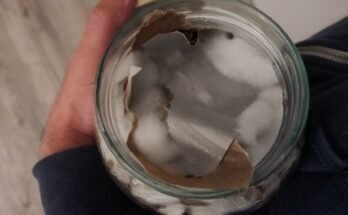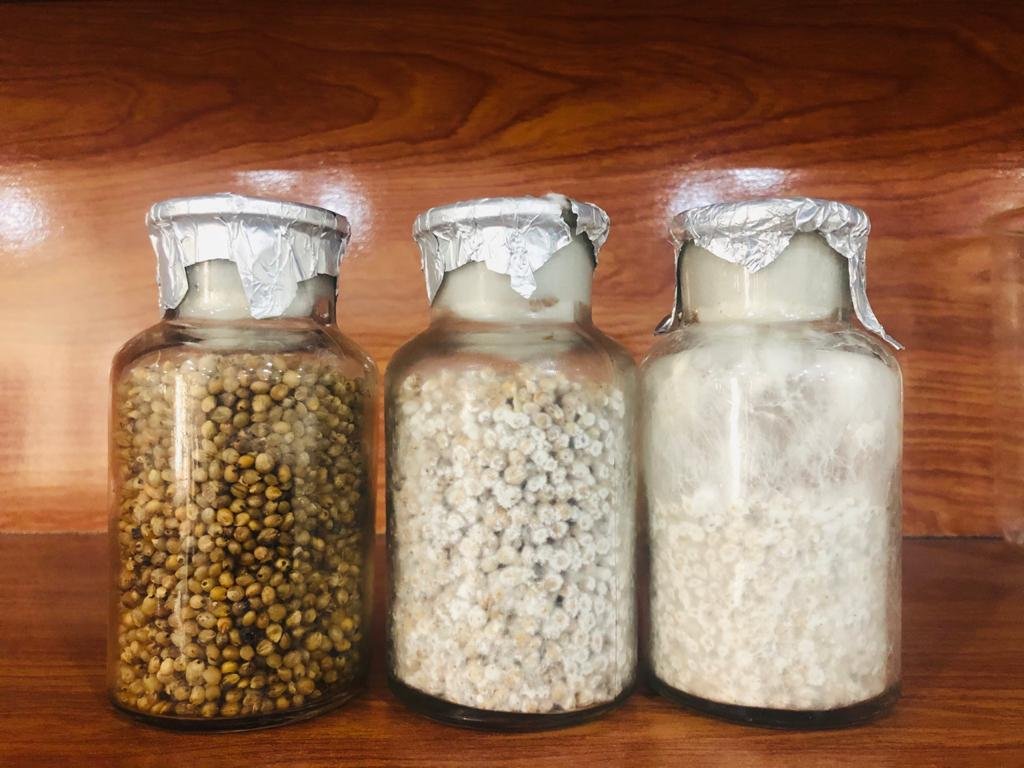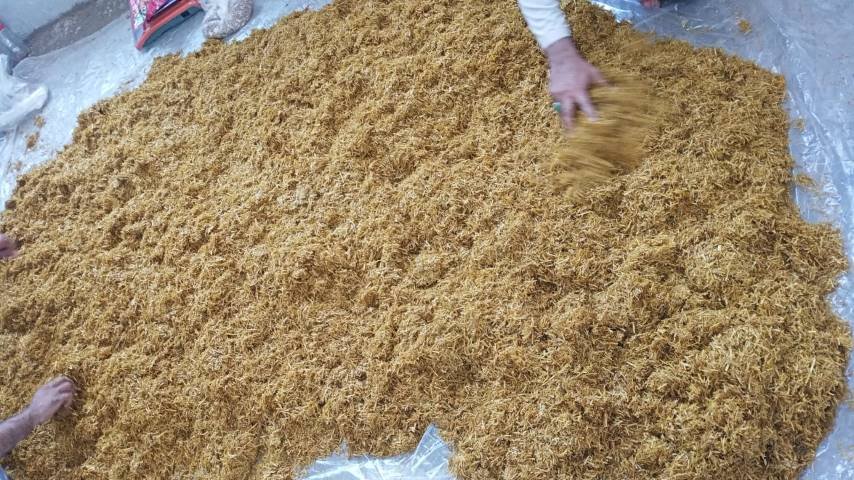Mushrooms lovers are surely familiar with the delicious oyster mushrooms. It is one of the most popular types of mushrooms and has been valued for its nutritional value and great taste. Oyster mushroom is a fast-growing and high-yielding crop with several amazing health benefits. It helps to lower down the cholesterol level and is also a rich source of protein, iron, and potassium. Oyster mushrooms are a sought-after delicacy in several countries of the world.
Oyster mushrooms are very easy to grow at home and don’t require a lot of expertise. All you need is a good quality spawn and a substrate to get started. Oyster mushrooms can grow on different types of substrates and provide appreciable results on all types of substrates. Selecting the right type of substrate that gives the best results is the key to obtain quicker and higher mushroom yield.
What is a substrate?
Substrates are by-products of agriculture, household waste, or industrial waste. These waste materials if carelessly disposed of by dumping or burning in the surrounding environment can cause environmental pollution that leads to several health problems. These resources can be utilized for growing mushrooms. Oyster mushroom procures its nutrition by decomposition of organic materials in the substrate. The yield of mushrooms largely depends upon the type of substrate on which it is growing. Different substrates have different yield potentials.
Finding the best substrate for growing your oyster mushroom is critical to increasing the chances of your success. So, how to pick the best substrate for growing oyster mushrooms?
Best substrates for oyster mushroom
Mushrooms convert the complex carbon-based dead plant matter into simpler substances to obtain their nutrition. They generally require carbon, nitrogen, and other inorganic compounds as a food source. They mainly obtain nutrition from carbon sources including lignin and cellulose. Oyster mushrooms need more carbon and less nitrogen. Therefore, several organic matters containing lignin, cellulose, and hemicellulose can be used as substrates for cultivating oyster mushrooms.
The efficacy of substrates varies depending upon the type of mushroom. Oyster mushrooms can grow on almost all types of substrates. Giving the right type of substrate is critical to ensure better yield and productivity of oyster mushrooms.
If you are interested in cultivating oyster mushrooms you must know which type of substrate is better with higher yield potential. Here are some of the best substrates for cultivating oyster mushrooms.
Straw
Straw is one of the best substrates which is rich in nutrients and provides a good yield of the oyster mushroom. Wheat, rice, oat, and rye straw are excellent substrates for growing oyster mushrooms. The good news is that you don’t need to spend a lot of money on buying the substrate. Straw is very inexpensive and easily available. Oyster mushrooms can easily break down the fibers of straw and obtain their nutrition.
I have obtained a pretty higher yield of oyster mushroom on wheat and paddy straw. Based on my own growing experience I would recommend straw as the number 1 substrate for cultivating oyster mushrooms.
If you plan to grow oyster mushrooms on straw, you need to do some preparations. The process of preparing the substrate is very easy. First, chop the straw into 3 to 5 inches pieces with a chopper or lawnmower. Then the chopped straw should be pasteurized or sterilized using heat. Heat pasteurization kills off all the microbes that can compete with oyster mushrooms and also kill off any cereal grains in the straw. Therefore, pasteurized straw provides better growth of the mycelium without any contamination and ultimately generates a higher yield.
Cotton waste
Cotton waste generated through the mechanical processing of raw cotton before spinning has been used as an ideal substrate for growing edible oyster mushrooms. The waste that would otherwise go to junk can be used for mushroom farming. Plus, it has been found as the best substrate regarding commercial-level production of oyster mushrooms. I would recommend cotton waste as the 2nd best substrate for growing oyster mushrooms after straw.
Cotton waste is rich in cellulosic material and provides high nutrition for the growth of mushrooms. Cotton waste supplemented with wheat or rice bran give a high yield of oyster mushrooms. Wheat or rice bran provides a rich source of proteins to improve the growth of oyster mushroom mycelium. These supplements also show a positive impact on the yield of oyster mushrooms.
Logs
Logs work as a great substrate for growing oyster mushrooms. Unlike other substrates, wood logs don’t need to be pasteurized. Wood logs are already moist and have bark that acts as a protective layer to slows down the moisture loss and provides a semi-sterile environment. Moreover, the live trees have active immunity that helps to fight contaminants.
You need to cut the wood logs and drill holes in them for spawning. The advantage of using logs is that they don’t require a lot of watering or maintenance. They must be set aside at a shady place with plenty of ventilation. But growing mushrooms on wood logs demands patience you need to wait for 12 to 18 months for the spawn to start growing and fruiting.
Logs are cut and inoculated with mushroom spawn. Preferably, use those logs on which oyster mushrooms grow naturally. To ensure success you need to do a little bit of research on the type of logs that are suitable for growing oyster mushrooms. Usually, oyster mushrooms grow on any hardwood that is not too dense and decomposes rapidly for example ash, elm, cottonwood, and alder. Oak works perfect and longer to grow oyster mushrooms.
Sawdust and woodchips
Sawdust and woodchips can be used to grow oyster mushrooms with good results. There are several recipes to prepare your sawdust on your own for growing oyster mushrooms at home. However, the best sawdust for growing oyster mushrooms comes from alder, sweetgum trees, and oak.
You can use pasteurize sawdust to grow mushrooms indoors. The most important thing about sawdust is that if it is used alone, it cannot produce a commercially viable crop. Sawdust is generally low in nutrients particularly nitrogen, it should be supplemented with some nutrient-rich substances like cotton cake, wheat bran, soya cake, etc. It is important to adjust the carbon-nitrogen ratio of the sawdust substrate before using it. On the other hand, woodchips can be used to grow oyster mushrooms in the outside environment. Woodchips also work fine to grow some other types of mushrooms like wine cap mushrooms or semi-wild type mushrooms.
Used Coffee Grounds
Oyster mushrooms can also be cultivated on coffee grounds. Coffee grounds have been frequently tested to provide a good yield of oyster mushrooms. They are rich in nutrients and readily available. You can utilize the nutrients in coffee grounds to produce mushrooms, that would have otherwise gone to waste.
Cultivating oyster mushrooms on coffee grounds is a very simple and easy task to do. The best thing about using coffee grounds as a substrate is that they are already sterilized during the process of brewing. So, unlike other substrates, you don’t need to perform the process of pasteurization separately. It will reduce the efforts involved in cultivating mushrooms thus it is easier for beginners to cultivate oyster mushrooms on coffee grounds.
Coco coir
Coco coir is prepared by the fibrous husk of coconut that is naturally resistant to pests, bacteria, and mold. Thus, it makes an ideal substrate for growing oyster mushrooms. It is a cheap substrate that can be easily pasteurized. If you chose coco coir for growing your oyster mushrooms that means you are choosing a sustainable and non-toxic resource. When hydrated coco coir expands up to 10 times you will be able to get the maximum benefit from a single block.
Coco coir’s resistance to pests and low maintenance requirement makes it a perfect choice for the beginner. Plus, coir is biodegradable, retains more moisture, and is often reusable which means you can get multiple harvests from the same substrate.
You can buy coco coir online or from any local grow stores or hydroponics. Coco coir is often used as a soil-less growing medium in aquaponics and hydroponics. If you haven’t tried coir as a substrate, then must give it a try, you will be amazed to see the incredibly high yield of your oyster mushrooms.
Supplements used with the substrates
Different supplements are added to agricultural wastes or substrates to improve the nutritional status for example gypsum, lime, and urea. Gypsum serves as a source of calcium and also regulates the pH or acidity level of the substrate. Moreover, the water holding capacity of gypsum is very high that helps to prevent the excessive wetting of the substrates. Oyster mushrooms need nitrogen for their better yield. To fulfill the requirement of nitrogen different supplements like wheat bran, molasses, sunflower seed, or urea are added to the substrates. Lime helps to adjust the pH level of the substrate.
Now you are familiar with different types of substrates and their benefits for growing oyster mushrooms. Please give it a try and share your results with us.




